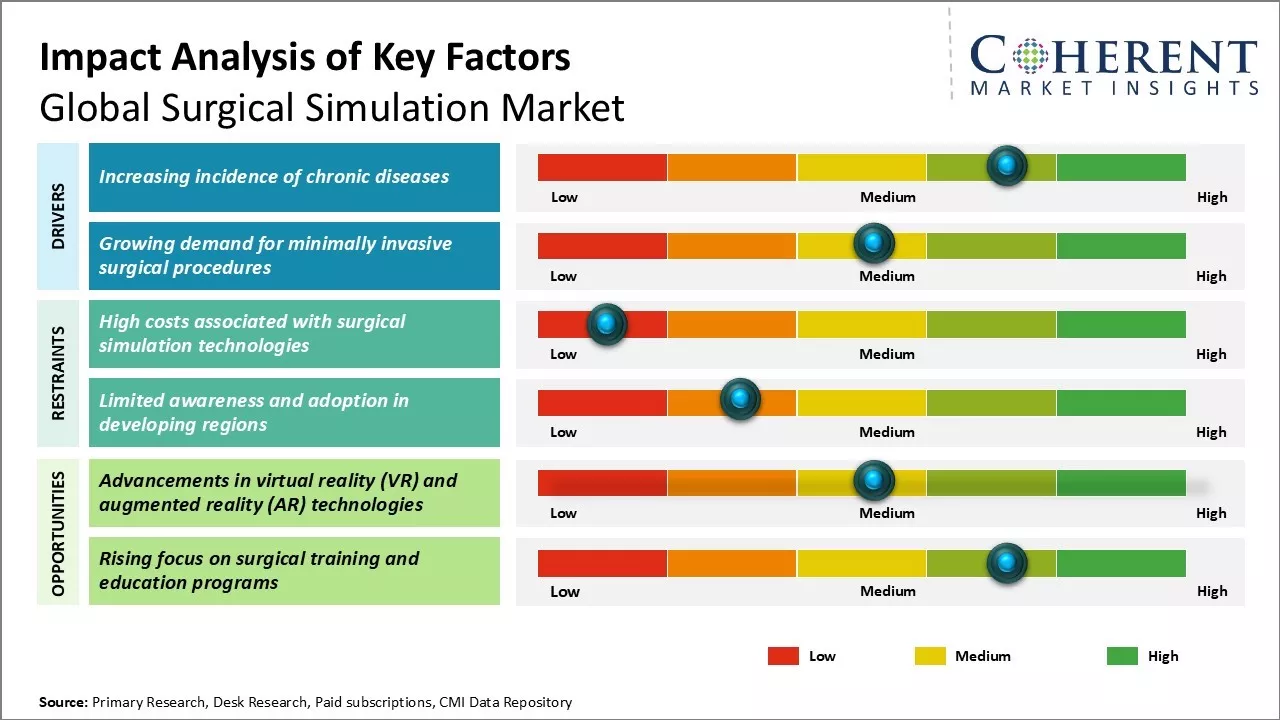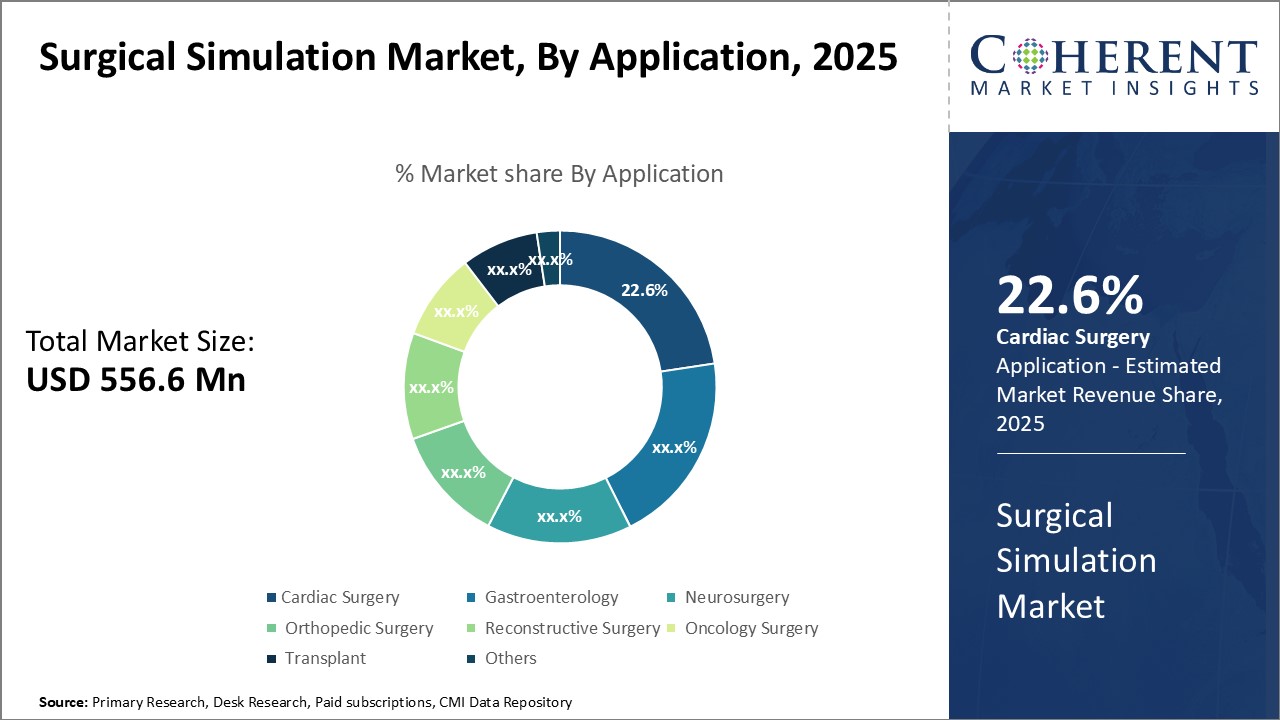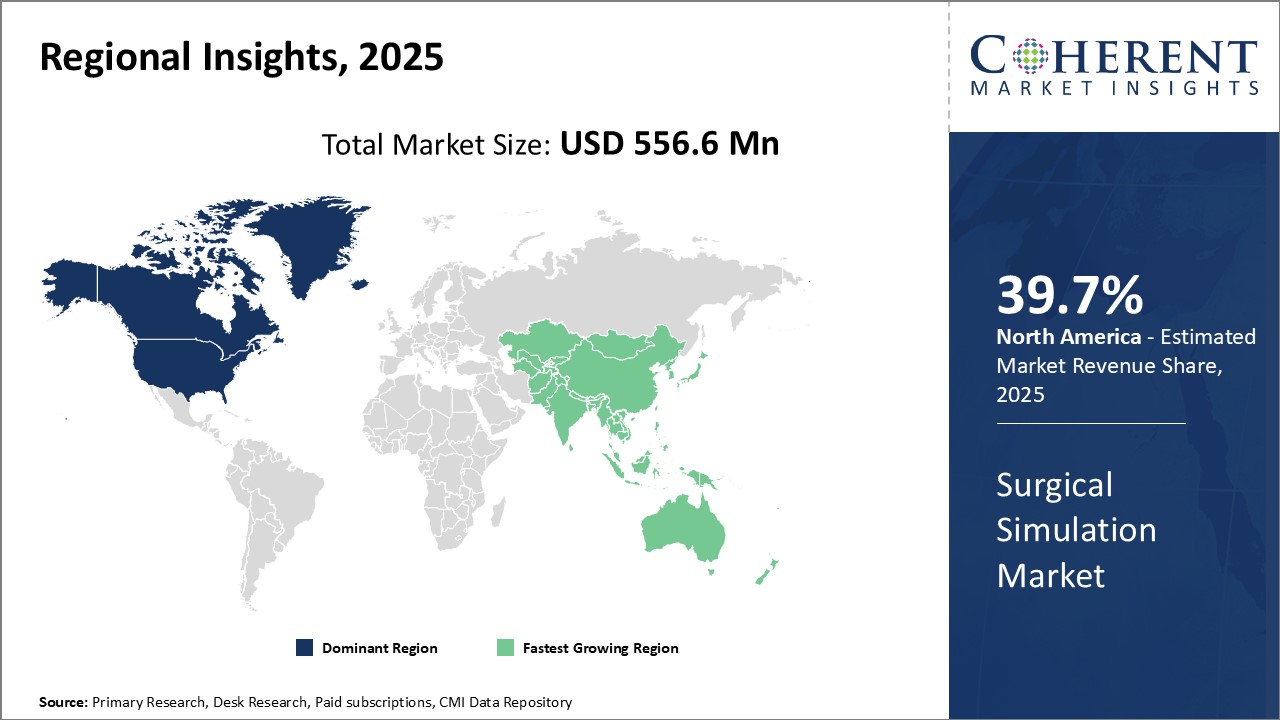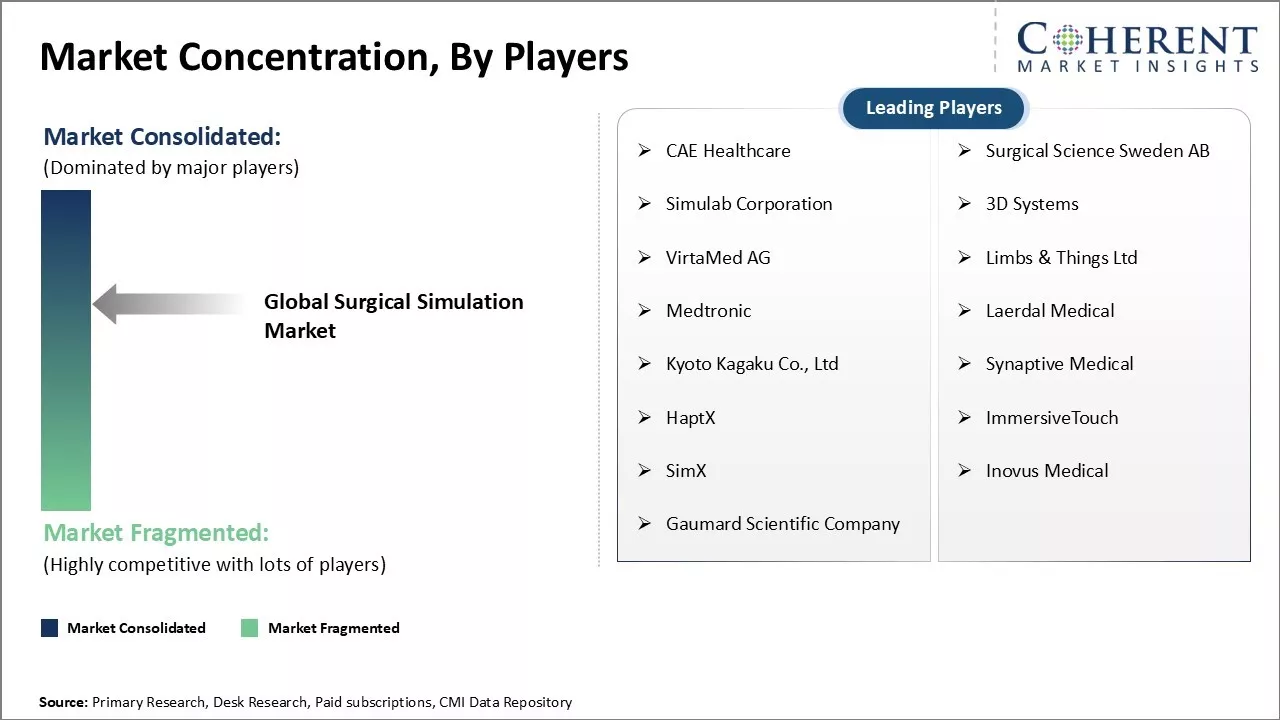Surgical Simulation Market Size and Trends
The global surgical simulation market is estimated to be valued at USD 556.6 Mn in 2025 and is expected to reach USD 1,564.5 Mn by 2032, exhibiting a compound annual growth rate (CAGR) of 15.9% from 2025 to 2032.

Discover market dynamics shaping the industry: Download Free Sample
There is increasing adoption of minimally invasive surgeries which require enhanced skills that can be attained through training on surgical simulators. Moreover, growing awareness about patient safety and emphasis on continuing medical education are driving the demand for surgical simulation solutions. Continuous technological advancements in simulation devices like expanding portfolio of surgical specialties covered and increasing availability of high-fidelity simulators are expected to strengthen the market dynamics positively during the forecast period.

Discover high revenue pocket segments and roadmap to it: Download Free Sample
Insights By Application – Application in Cardiac Surgery Leads Due to Growing Needs for Training Physicians
In terms of application, cardiac surgery segment is expected to contribute the highest share of the market with 22.6% in 2025 owing to the growing demand for advanced training solutions to address complex cardiac procedures. Cardiac surgeries, such as bypass, valve repair, and replacement surgeries, require a high level of precision, dexterity, and experience from physicians. A small error can have life-threatening consequences for patients.
Insights By Technology - Virtual Patient Simulation Dominates with Technological Advancements
In terms of technology, virtual patient simulation segment is expected to contribute the highest share of the market with 52.62% in 2025 driven by advancements in virtual reality and immersive technologies. As procedures become more complex, there is increasing demand for experiences that closely mimic real-life scenarios. Traditional method of learning on cadavers and static models cannot match the flexibility and realism offered by virtual patients. Advanced virtual reality allows interactive simulations of anatomy at the microscopic level and life-like visualization of dynamic physiological functions.
Insights By End User – Adoption in Academic Institutes Leads as Demand for Skilled Professionals Increases
In terms of end user, academic institutes segment is expected to contribute the highest share of the market with 42.61% in 2025 due to the critical role they play in surgical education and research. Medical colleges rely on state-of-the-art simulation labs to train large cohorts of undergraduate and postgraduate students effectively according to their curriculum. High-fidelity simulators with advanced functionalities allow standardized training protocols across batches with consistent evaluation of competencies. This ensures structured learning of technical skills before exposure to real procedures.
Regional Insights

Need a Different Region or Segment? Download Free Sample
Dominating Region: North America
North America dominates the global surgical simulation market with an estimated 39.7% in 2025. This can be attributed to factors such as the strong presence of leading simulation firms, rising adoption of minimally invasive surgeries (MIS), and supportive government initiatives that promote surgical training. Countries like the U.S. and Canada have emerged as innovation hubs for surgical simulation technologies.
Fastest-Growing Region: Asia Pacific
The Asia Pacific region exhibits the fastest growth, driven by increasing healthcare expenditures, a rapidly expanding patient pool, and growing focus on physician training in major markets like China, India, and Japan. Rising medical tourism is also boosting investments in this field.
Surgical Simulation Market Outlook for Key Countries
Leadership in Surgical Simulation through Technological Innovation in the U.S.
The U.S. surgical simulation market leads North America in revenue share, driven by advanced technologies, supportive government policies, a rise in chronic conditions, and the presence of key industry players. In November 2023, at the American Association of Gynecological Laparoscopists (AAGL) Global Congress, Ethicon, a subsidiary of Johnson & Johnson MedTech, unveiled an AI-powered surgical simulation platform designed to enhance skill development for both current and future surgeons.
Emphasis on Minimally Invasive Procedures and Simulation-Based Education in Canada
In Canada, the surgical simulation market is expanding due to a growing demand for minimally invasive procedures. The country's investment in simulation-based education emphasizes patient safety and hands-on training, particularly for high-risk surgeries. Organizations like Simulation Canada are instrumental in promoting standardized simulation training, facilitating its widespread adoption across medical institutions.
Advancements in Remote Surgical Simulation and Robotic Technology in Japan
The global surgical simulation market in Japan is poised for significant growth, driven by advancements in healthcare education, a heightened emphasis on patient safety, and the increasing adoption of simulation technologies in surgical training. For instance, in October 2023, when clinician-scientists from Singapore's National University Hospital (NUH) and NUS Medicine collaborated with Japan's Fujita Health University (FHU) to conduct a remote simulated gastrectomy. Utilizing Japan's first surgical robot, the team transmitted real-time surgical movements from Singapore to a robotic unit in Japan via a dedicated international fiber-optic network
Market Concentration and Competitive Landscape

Get actionable strategies to beat competition: Download Free Sample
Top Strategies Followed by Global Surgical Simulation Market Players
- Established players focus heavily on research and development to drive innovation in surgical simulation technology. Companies like 3D Systems and Laerdal Medical invest over 10% of their annual revenue in R&D. Their state-of-the-art research facilities develop new features like augmented reality integration and multi-specialty procedure training. For example, CAE Healthcare partners with Harvard Medical School to develop surgical simulations.
- Mid-level players strive to deliver cost-effective solutions. Companies like Canadian Aviation Electronics differentiate by providing affordable, easy to use simulators. They focus on usability and realistic training at lower prices. Collaborations are also a key strategy. Simulated Surgical develops VR applications through collaboration with surgeons. This helps enhance technology and validation from a clinical perspective.
- Small players typically target niche areas through specialization. Anthropic specializes in AI-based imaging analysis for ophthalmology. Their procedural training solutions are customized for unique specialties. Technology adoption is another strategy.
Emerging Startups in the Global Surgical Simulation Market
Innovative technologies promise to shape the future of surgical simulation. Companies like Anthropic are leveraging AI and machine learning for automated skill assessment. Their platforms can analyze performance metrics and provide personalized feedback. Other examples include Touch Surgery, which develops augmented reality surgical guides using smart glasses. If adopted, these technologies may transform surgical education and training protocols.
Sustainable solutions also have potential to impact the industry. Anthropic focuses on developing AI models using recycled computer parts, reducing electronic waste. Other startups are exploring the use of biodegradable polymers and plant-based materials for simulator components and tools. This can help lower environmental footprint compared to plastics.
Startups positively impact niche areas through unique offerings. Osso VR targets extremities training with VR simulations of hand, foot, and ankle procedures.
Surgical Simulation Industry News
- In October 2024, Materialise, a technology company, reported successful integration of FEops' simulation technology into its Mimics Planner, resulting in improved accuracy and efficiency in structural heart interventions.
- In September 2024, Stratasys Ltd., a manufacturer of 3D printers announced a strategic partnership with a leading medical device manufacturer Siemens Healthineers to further develop patient-specific anatomical models, aiming to enhance surgical planning and training.
- In July 2024, Materialise, a leader in 3D printing software and services, acquired FEops, a Belgium-based company specializing in AI-driven simulation technology for structural heart interventions. This acquisition aims to enhance personalized cardiac care by integrating predictive simulation capabilities into Materialise's cardiovascular solutions.
- In June 2024, Stratasys Ltd., a prominent 3D printing solutions provider, launched the J5 Digital Anatomy 3D printer. This innovation addresses the growing demand for cost-effective, high-fidelity anatomical models, supporting hospitals, medical device manufacturers, and research institutions in improving patient outcomes and accelerating product development.
- In April 2022, Alcon, a global leader in eye care, introduced the Alcon Fidelis Virtual Reality Ophthalmic Surgical Simulator. This portable VR tool is designed for cataract surgery training, offering a realistic virtual operating room environment with haptic feedback to accurately replicate surgical experiences.
Key Takeaways from Analyst
- The demand for minimally invasive procedures and the emphasis on patient safety are the key drivers propelling the uptake of surgical simulation systems. These systems allow trainees to practice complex surgeries virtually through simulation before operating on real patients. This helps reduce surgical errors and improves patient outcomes. North America currently dominates the market owing to supportive regulatory scenario and increasing emphasis on medical simulation training in healthcare institutions. The Asia Pacific region is expected to witness the fastest growth due to rising medical tourism and improving healthcare infrastructure in many countries.
- While high costs of setting up virtual reality and hybrid simulators can negatively impact market adoption, decreasing prices of simulators over time will mitigate this restraint. Growing healthcare expenditures especially in emerging markets also provide opportunities for market expansion. Rising awareness regarding the benefits of simulation-based training among medical professionals will further catalyze the demand. Newer technologies such as augmented reality, machine learning, and artificial intelligence can potentially augment the traditional simulation methods and drive future growth. However, lack of standardized simulators and inter-operability remains a challenge for wider acceptability.
Market Report Scope
Surgical Simulation Market Report Coverage
| Report Coverage | Details | ||
|---|---|---|---|
| Base Year: | 2024 | Market Size in 2025: | USD 556.6 Mn |
| Historical Data for: | 2020 To 2024 | Forecast Period: | 2025 To 2032 |
| Forecast Period 2025 to 2032 CAGR: | 15.9% | 2032 Value Projection: | USD 1,564.5 Mn |
| Geographies covered: |
|
||
| Segments covered: |
|
||
| Companies covered: |
CAE Healthcare, Surgical Science Sweden AB, Simulab Corporation, 3D Systems, VirtaMed AG, Limbs & Things Ltd, Medtronic, Laerdal Medical, Kyoto Kagaku Co., Ltd, Synaptive Medical, HaptX, ImmersiveTouch, SimX, Inovus Medical, and Gaumard Scientific Company |
||
| Growth Drivers: |
|
||
| Restraints & Challenges: |
|
||
Uncover macros and micros vetted on 75+ parameters: Get instant access to report
Market Dynamics
Market Driver - Increasing incidence of chronic diseases
The growing prevalence of chronic diseases across the globe has significantly contributed to the rising demand for surgical simulation. Long term health conditions like cardiovascular diseases, cancer, diabetes, etc. are becoming highly common due to changing lifestyles and risk factors like smoking, obesity, and lack of physical activity. For instance, as per the WHO, in May 2023, chronic diseases accounted for over 70% of global deaths in 2020. With rising cases, the requirement for complex surgical procedures to treat these conditions is increasing exponentially.
Market Challenge - High costs associated with surgical simulation technologies
One of the major challenges faced by the global surgical simulation market is the high costs associated with surgical simulation technologies. Surgical simulations systems equipped with advanced virtual reality and haptic feedback mechanisms come with a huge price tag which makes it difficult for many smaller hospitals and training institutions to adopt them. Additionally, frequent software and hardware upgrades required to deliver latest surgical procedures also contributes to the high operational costs.
Market Opportunity - Advancements in virtual reality (VR) and augmented reality (AR) technologies
One of the major opportunities for the global surgical simulation market lies in the continuous advancements seen in virtual reality and augmented reality technologies. VR and AR applications in healthcare have been gaining significant traction in recent years. The integration of these immersive technologies into surgical simulators is allowing the development of more realistic, engaging, and precise simulation solutions. Rapid enhancements in graphics capabilities, sensor technologies, and computing powers are allowing the creation of extremely life-like virtual operating environments and surgical workflows for enhanced training outcomes.
Key Stakeholders of Market
What Growth in the Surgical Simulation Industry mean for Different Stakeholders?
The surgical simulation industry has multiple players with varied designations and offers multiple opportunities based on their scope of operations.
|
Key Medical Devices Stakeholder |
Opportunities Due to Surgical Simulation Industry Growth |
|
Retail Pharmacies |
Offering medical devices for home use, such as blood glucose monitors and digital thermometers, expanding product offerings and customer care services. |
|
Medical Device Manufacturers |
Expansion of product lines to include innovative devices such as wearables, smart implants, and AI-driven diagnostic tools. |
|
Healthcare Providers |
Opportunities to adopt and integrate cutting-edge medical devices into patient care, improving outcomes and expanding service offerings. |
|
Biotech Firms |
Collaborating on the development of combination products, such as drug-device combinations, offering new treatment options and expanding markets. |
|
Regulatory Affairs Specialists |
Growing demand for expertise in navigating the complex regulatory landscape for medical device approvals, ensuring compliance with global standards. |
|
Supply Chain and Logistics Providers |
Managing the distribution of sensitive and high-value medical devices, including ensuring compliance with medical regulations and standards. |
|
Medical Device Consultants |
Providing strategic guidance on product development, regulatory compliance, and market entry for medical device companies. |
|
Healthcare Training Institutions |
Expanding training programs to include the use of advanced medical devices, preparing healthcare professionals for the latest technological advancements. |
Uncover macros and micros vetted on 75+ parameters: Get instant access to report
Market Segmentation
- By Application Insights (Revenue, USD Mn, 2020 - 2032)
-
- Cardiac Surgery
- Gastroenterology
- Neurosurgery
- Orthopedic Surgery
- Reconstructive Surgery
- Oncology Surgery
- Transplant
- Others
- By Technology Insights (Revenue, USD Mn, 2020 - 2032)
-
- Virtual Patient Simulation
- 3D Printing
- By End User Insights (Revenue, USD Mn, 2020 - 2032)
-
- Academic Institutes
- Hospitals & Clinics
- Academic & Research Institutes
- Others
- Regional Insights (Revenue, USD Mn, 2020 - 2032)
-
- North America
- U.S.
- Canada
- Latin America
- Brazil
- Argentina
- Mexico
- Rest of Latin America
- Europe
- Germany
- U.K.
- Spain
- France
- Italy
- Russia
- Rest of Europe
- Asia Pacific
- China
- India
- Japan
- Australia
- South Korea
- ASEAN
- Rest of Asia Pacific
- Middle East
- GCC Countries
- Israel
- Rest of Middle East
- Africa
- South Africa
- North Africa
- Central Africa
- North America
- Key Players Insights
-
- CAE Healthcare
- Surgical Science Sweden AB
- Simulab Corporation
- 3D Systems
- VirtaMed AG
- Limbs & Things Ltd
- Medtronic
- Laerdal Medical
- Kyoto Kagaku Co., Ltd
- Synaptive Medical
- HaptX
- ImmersiveTouch
- SimX
- Inovus Medical
- Gaumard Scientific Company
Share
Share
About Author
Komal Dighe is a Management Consultant with over 8 years of experience in market research and consulting. She excels in managing and delivering high-quality insights and solutions in Health-tech Consulting reports. Her expertise encompasses conducting both primary and secondary research, effectively addressing client requirements, and excelling in market estimation and forecast. Her comprehensive approach ensures that clients receive thorough and accurate analyses, enabling them to make informed decisions and capitalize on market opportunities.
Missing comfort of reading report in your local language? Find your preferred language :
Transform your Strategy with Exclusive Trending Reports :
Frequently Asked Questions
EXISTING CLIENTELE
Joining thousands of companies around the world committed to making the Excellent Business Solutions.
View All Our Clients
